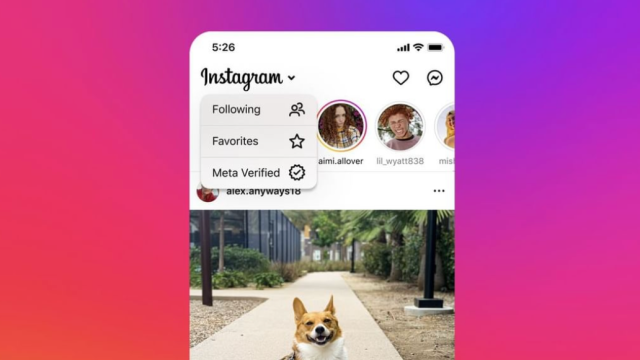On Monday, Instagram announced it’s testing a feed that only shows posts from verified accounts. This new way for “businesses and creators to get discovered” is part of a broader push across the social media industry, where the apps are rolling out the blue-checked carpet to encourage people to pay for a boost in the algorithm. It makes for a tidy new revenue stream—and a devil’s bargain that harms user experience by filling apps with low-quality content.
“We’re testing a way for people to explore their Instagram feed and reels by toggling to only Meta Verified accounts,” said Instagram head Adam Mosseri on his broadcast channel. The executive shared a screenshot, picture above, that shows a drop-down menu where you can switch over to look at the verified accounts in all their glory.
The real question is why you, an Instagram user, would ever want to do that. In the past, verification was a sign that the social media gods had decided an account was notable. Now, it’s just a sign that someone has disposable income and is willing to use it to spread their posts.
Meta Verified is a $US11.99-a-month service that the company pitches as a way to “establish your account’s authenticity,” boasting extra perks like more security protections and access to exclusive features. What Meta doesn’t mention as explicitly is something that social media grifters know all too well: just like on Twitter (a.k.a. X), a blue checkmark on Facebook, Instagram, and Threads comes with extra attention from the algorithm, making it more likely that people will see your content.
Of course, the old verification regime was no paradise. Elon Musk once chastised Twitter’s blue-check establishment as a “lords and peasants system.” He had a point. Before the billionaire’s tenure, Twitter was divided into a landscape of haves and have-nots. Verified accounts always got more views and dominated the conversation. The checkmark was a sign that you had “arrived,” in one way or another, deservedly or not. There were plenty of well-deserving users who never got the nod, and plenty of verifications were handed out as personal favors to friends of employees and other people who didn’t seem to add much to the discourse.
But while Musk had genuine complaints, he’s made it clear that charging for verification was really just about making a few extra dollars. Once the dust settled on Musk’s plan, Meta quickly followed suit. Facebook and Instagram (followed later by Threads) abandoned their traditional verification systems, turning them into paid services and proving that Musk’s idea made business sense, at least in the short term.
Musk’s verification changes made a dramatic adjustment to Twitter’s algorithm, filling users’ feeds with posts from his new army of sycophants. Not only are you more likely to see posts from verified X users you don’t even follow, but their comments show up at the top when you drill in to look at the post and get a feel for the discourse. These are not maverick posters, social media stars, or public figures. They’re just people who spent $US8 for the privilege of a megaphone.
The consequences are far more significant than a less satisfying scroll, however. A recent study found that seven verified accounts on X are controlling the news about Israel and Palestine on the platform. These so-called “New Elites” of Twitter generated 1.6 billion views in the first three days after the Hamas attacks on October 7th, ten times more engagement than the most popular news accounts from the likes of the BBC, the New York Times, and Reuters combined. These aren’t reporters broadcasting their boots-on-the-ground citizen journalism. They’re just people reposting context-free information that they scrape from other news sources, generally with little to no effort spent on verifying the information.
Add that to other research which shows that verified users produce 74% of the misinformation on X, which then spreads to the rest of the internet, and you’ve got crisis levels of low-quality information flooding the world’s primary channels of communication.
Meta and X could discover that people don’t like these changes and reverse course, but that isn’t how things have gone in the past in the past. Take the News Feed. Originally, Facebook was just a collection of profile pages you’d visit when you wanted to see specific friend’s content. But in 2006, the website moved the primary experience of the platform to an algorithmic feed—a move that was actually copied from Twitter, which made a similar change just months earlier. It caused a revolt. Users hated the change, but the algorithmic feed was stickier. The News Feed kept people glued to their screens and made the company more money, and Facebook stuck to its guns.
Instagram offers a more recent example. In 2022, the app was in serious decline, in part because of competition from TikTok. In classic Meta fashion, Instagram copied many of TikTok’s most successful features, including filling the app with more video content and posts from accounts users don’t follow. Over the next few months, there was an international protest to “Make Instagram Instagram Again,” drawing support from the likes of Kim Kardashian and other celebrities. It was a lost cause; the new Instagram is here to stay.
In all likelihood, the rise of paid blue-checked content boosts will be permanent too. Meta, in general, moves more carefully than its would-be competitors at X. Instagram and Facebook users are far more likely to see boosted content from accounts they don’t follow, but the feeds aren’t nearly as compromised as they are on Twitter. If Instagram’s latest experiment proves a success, and the company learns it can get away with a new channel to encourage people to hand over cash, expect to see a lot more blue checks in the near future.
